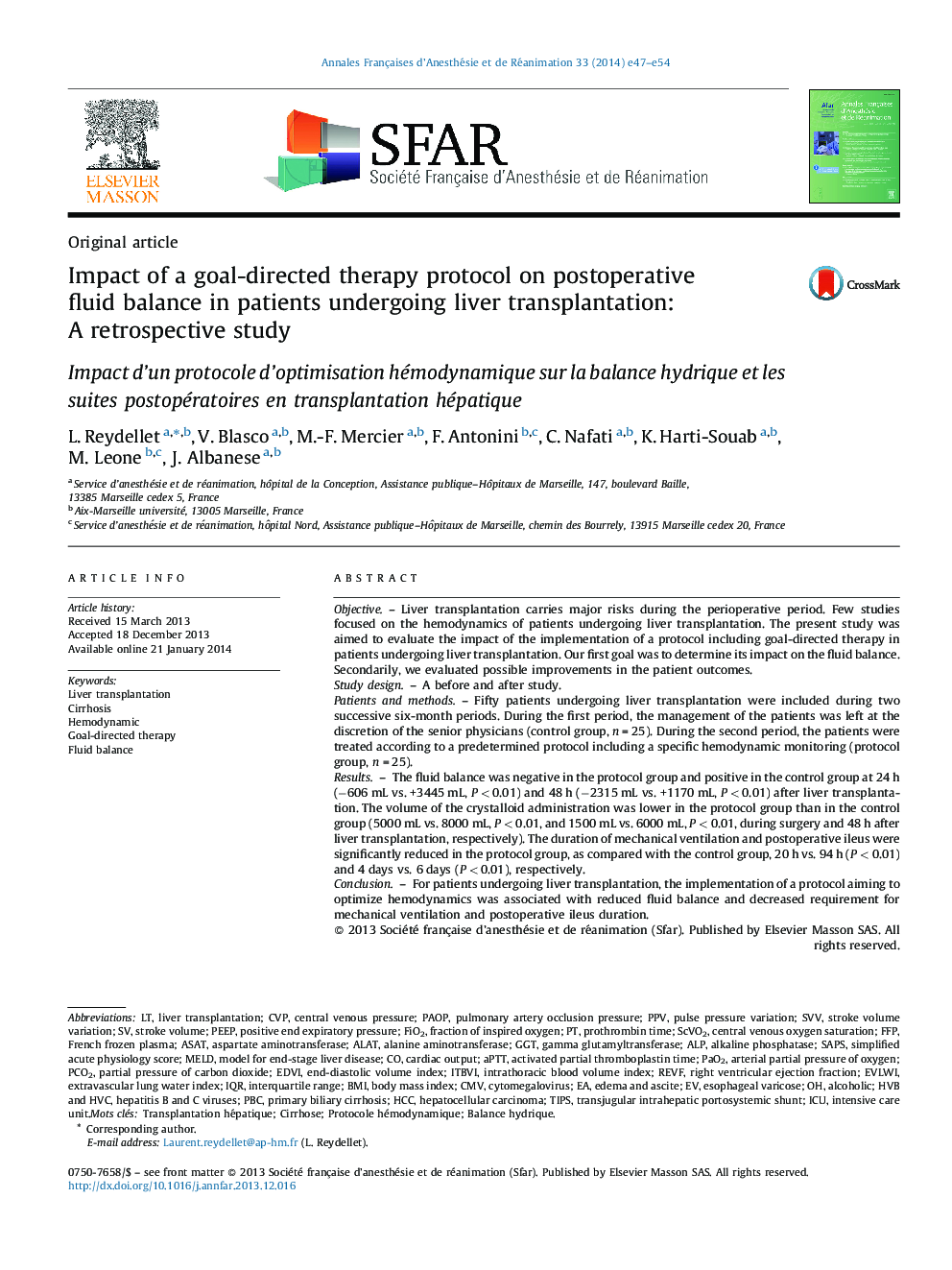| Article ID | Journal | Published Year | Pages | File Type |
|---|---|---|---|---|
| 2745282 | Annales Françaises d'Anesthésie et de Réanimation | 2014 | 8 Pages |
ObjectiveLiver transplantation carries major risks during the perioperative period. Few studies focused on the hemodynamics of patients undergoing liver transplantation. The present study was aimed to evaluate the impact of the implementation of a protocol including goal-directed therapy in patients undergoing liver transplantation. Our first goal was to determine its impact on the fluid balance. Secondarily, we evaluated possible improvements in the patient outcomes.Study designA before and after study.Patients and methodsFifty patients undergoing liver transplantation were included during two successive six-month periods. During the first period, the management of the patients was left at the discretion of the senior physicians (control group, n = 25). During the second period, the patients were treated according to a predetermined protocol including a specific hemodynamic monitoring (protocol group, n = 25).ResultsThe fluid balance was negative in the protocol group and positive in the control group at 24 h (−606 mL vs. +3445 mL, P < 0.01) and 48 h (−2315 mL vs. +1170 mL, P < 0.01) after liver transplantation. The volume of the crystalloid administration was lower in the protocol group than in the control group (5000 mL vs. 8000 mL, P < 0.01, and 1500 mL vs. 6000 mL, P < 0.01, during surgery and 48 h after liver transplantation, respectively). The duration of mechanical ventilation and postoperative ileus were significantly reduced in the protocol group, as compared with the control group, 20 h vs. 94 h (P < 0.01) and 4 days vs. 6 days (P < 0.01), respectively.ConclusionFor patients undergoing liver transplantation, the implementation of a protocol aiming to optimize hemodynamics was associated with reduced fluid balance and decreased requirement for mechanical ventilation and postoperative ileus duration.
RésuméObjectifsLa transplantation hépatique est une chirurgie à haut risque périopératoire. Peu d’études se sont intéressées à la gestion hémodynamique des patients bénéficiant d’une transplantation hépatique. Le but de notre étude était d’évaluer l’impact d’un protocole d’optimisation hémodynamique périopératoire sur la balance hydrique. Les objectifs secondaires étaient d’étudier les conséquences sur les durées de ventilation, d’iléus, de séjour et sur la morbi-mortalité postopératoire.Type d’étudeÉtude avant–après.Patients et méthodesCinquante patients bénéficiant d’une transplantation hépatique ont été inclus pendant deux périodes successives de 6 mois. Pendant la première période, la gestion hémodynamique et transfusionnelle des patients était libre (groupe témoin, n = 25). Pendant la seconde période, un protocole d’optimisation hémodynamique avec des objectifs précis et une réduction des apports hydriques de base a été mis en place (groupe protocole, n = 25).RésultatsLa balance hydrique était négative dans le groupe protocole et positive dans le groupe témoin à 24 heures (−606 mL vs. +3445 mL, p < 0,01) et à 48 heures (−2315 mL vs. +1170 mL, p < 0,01) après la transplantation hépatique. Le volume de cristalloïdes administré était plus faible dans le groupe protocole que dans le groupe témoin en peropératoire (5000 mL vs. 8000 mL, p < 0,01) mais aussi pendant les 48 heures postopératoires (1500 mL vs. 6000 mL, p < 0,01). Les durées de ventilation mécanique et d’iléus postopératoire étaient significativement réduites dans le groupe protocole, 20 h vs. 94 h (p < 0,01) et 4 jours vs. 6 jours (p < 0,01), respectivement.ConclusionChez les patients bénéficiant d’une transplantation hépatique, l’utilisation d’un protocole de monitorage et d’optimisation hémodynamique était associée à une réduction de la balance hydrique périopératoire ainsi qu’une réduction des durées de ventilation mécanique et d’iléus postopératoire.
